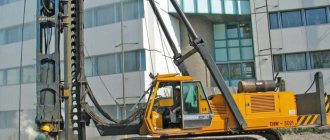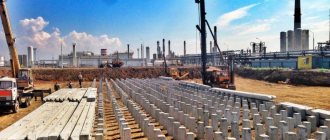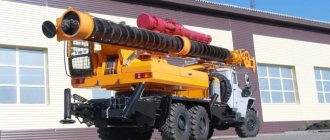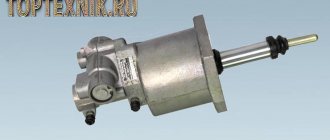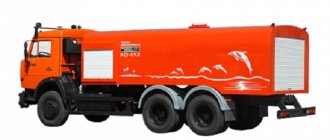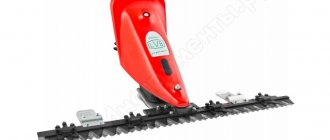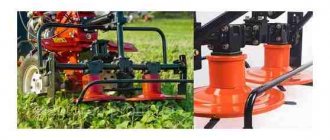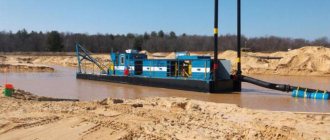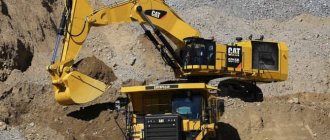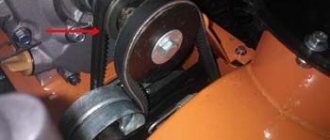The piling rig owes its popularity to the development of construction technologies at the end of the last century. The use of such products made it possible to create a solid foundation (and therefore conduct construction in general) on weak soils in which dense layers lie too deep. After all, before there was no pile-driving equipment, so driving piles to 12 m (or up to this mark) was almost impossible. A technically advanced and modern pile driver will easily complete this task.
Operating principle of pile driving machines
The principle of operation (that is, driving) consists of only two phases:
- Support installations. A leader hole is drilled at the desired point, the support is pulled either using special equipment or a pile driver (special pile driving machine). Afterwards it is lifted and installed in the well in the correct position;
- Driving piles. It is carried out by a special device when the hammer begins to hit the top of the pile. The dive is carried out to a certain depth, under the influence of impacts and the support’s own weight.
Pile drivers of various types for rent
We offer various types of pile driving machines for rent:
- on wheels (mobile pile drivers)
- tracked (heavy, high-performance vehicles)
When performing large volumes of work, such as installation of pile fields under the foundation of a multi-story building, tracked pile drivers are used that are capable of driving large piles. Such pile driving machines are characterized by higher productivity
Transportation of a caterpillar pile driver to the customer
To install a small number of piles (for example, under the foundations of low-rise buildings), pile driving machines, such as wheeled pile drivers, are used. They are also used if the submersible supports are located at a distance from each other (foundations for power transmission line supports)
Important! Wheeled copra machines are able to get to sites under their own power, which results in a lower cost of renting them. However, in terms of productivity, they are noticeably inferior to tracked pile driving machines.
Wheeled pile drivers are extremely mobile equipment
Both wheeled and tracked pile drivers can be used to implement the following projects:
- installation of foundations for single and multi-storey residential buildings, dachas and cottages;
- construction of foundations for industrial premises, including prefabricated reinforced concrete structures;
- installation of power line supports and cellular communication masts;
- driving sheet piles to enclose pits, strengthen slopes and create sealed reservoirs in the ground;
- dynamic testing of existing foundations.
Separately, we can highlight the BM-811 drilling and piling machine - this is a multifunctional equipment that, in addition to driving piles, can drill wells for bored supports.
Piling machine design
Pile driving machines are a large complex mounted on a wheeled or tracked base. Modern models most often belong to self-propelled units, but occasionally there are types transported by a tractor.
Pile driving construction equipment is equipped with a boom or mast. They are the ones who lift and hold the pile in a vertical position, picking it up with special manipulators. Afterwards, special impact equipment is used for driving, which can be:
- Diesel - the operating principle is based on the combustion of fuel, which lifts the hammer to the required height;
- Hydraulic - capable of changing the force of impact, which makes them universal (used on any soil);
- Pneumatic - compressed air is used instead of fuel.
Piling hammer
The hammer is the main working part of the pile driver; Depending on the operating principle and design features, it is available in several versions. Of these, the following are used in mass construction:
- Diesel,
- Hydraulic.
Diesel engines are gradually being replaced by hydraulic ones due to higher production and operational parameters.
Diesel hammer
The most widely used hammer in construction is the diesel hammer. Thanks to the simplicity and reliability of the design and fairly high performance. It requires minimal maintenance and is not burdened with any additional equipment. It operates on the principle of a direct-acting two-stroke diesel engine. After installing the pile under the head of the diesel hammer, it is launched as follows: using a winch, the impact part is lifted with a grapple and then, after releasing the grapnel hook, it is dropped down. When the striker falls, a portion of diesel fuel in the combustion chamber ignites and, under the influence of an explosion, the striker flies up to a certain height in order to fall again and strike the striker. And so the process is repeated cyclically until the supply of diesel fuel is stopped.
Diesel hammers are divided into tubular and rod type according to the type of guides. According to the mass of the striking part, diesel hammers are divided into light (up to 600 kg), medium (up to 1800 kg) and heavy (over 2500 kg).
Today, modern diesel rod hammers with an impact section of 3.5-4.5 tons provide excellent impact force. They are used for driving light, medium, and heavy reinforced concrete piles, steel pipes and sheet piles when constructing sheet piles for pits and trenches - in weak and medium-density soils.
Designations in the figure: 1 - pile; 2 - chabot; 3 — piston block, piston with a group of compression rings; 4 — vertical guide rods; 5 - shock part; 6 — cat with a fixing hook; 7 — plunger fuel pump; 8 — fuel tank; 9 - nozzle that injects and sprays fuel into the combustion chamber.
Technical characteristics of diesel rod hammers
Name
| SP60 | SP60A | SP4 | SP5 | SP6VM | SP7 | SP8 | |
| Impact mass, t | 0,24 | 0,25 | 1,25 | 1,8 | 2,5 | 3 | 3,5 |
| Maximum impact energy, kJ | 1,7 | 1,75 | 14,7 | 22,25 | 37,6 | 42,4 | 51,5 |
| Maximum mass of driven piles, t | 0,4 | 0,4 | 3,2 | 3,2 | 3,2 | 4 | 4 |
| Weight, t | 0,4 | 0,4 | 2,5 | 3,1 | 4,2 | 4,7 | 5,2 |
| Overall dimensions, mm | |||||||
| Height | 1980 | 2200 | 3850 | 4000 | 4630 | 4630 | 4630 |
| Length | 500 | 550 | 915 | 915 | 950 | 950 | 950 |
| Width | 550 | 500 | 905 | 905 | 1100 | 1100 | 1100 |
Tubular diesel hammers are used for driving reinforced concrete piles weighing 1.2-10 tons into any non-rocky soil types. They can operate in a wide range of ambient temperatures from -40 to +40 °C. But, like any diesel engine, at low temperatures they require preheating.
Designations in the figure: 1 - chabot; 2 — suction-exhaust pipe; 3 - guide cylinder; 4 — piston-striker (impact part); 5 - cat; 6 — cat cable; 7 — drive lever of the fuel pump; 8 - fuel pump; 9 - working cylinder.
Technical characteristics of tubular diesel hammers
| Name | SP74 | SP75A | SP76A | SP77A | SP78A | SP79A |
| Impact mass, t | 0,6 | 1,25 | 1,8 | 2,5 | 3,5 | 5 |
| Maximum impact energy, kJ | 14 | 29 | 42 | 59 | 82 | 118 |
| Weight of driven piles, t | 0,6-12 | 1,2-3,0 | 1,8-5,0 | 2,6-2,5 | 3,5-8,0 | 10 |
| Weight, t | 1,5 | 2,7 | 3,85 | 5,5 | 7,7 | 10 |
| Overall dimensions, mm | ||||||
| Height | 4075 | 4500 | 4500 | 5200 | 5500 | 5800 |
| Length | 430 | 750 | 800 | 920 | 1000 | 1000 |
| Width | 664 | 600 | 600 | 730 | 950 | 950 |
A special feature of the installation for driving piles in difficult soil conditions is the mandatory preliminary leader drilling of wells. This allows you to reduce the number of damaged supports when striking with a chabot. And in some cases, this addition is the only way to achieve the design depth. After completing the well, the mounted drilling equipment on the installation mast is moved to the side, giving way to the next stage - installing the pile at a point and driving it.
Hydraulic hammer for driving piles
A hydraulic hammer is superior to a diesel hammer in some technical characteristics, but is inferior in cost (it is noticeably more expensive and not every company that installs pile foundations can afford to have it in its fleet of equipment).
In terms of technical design, this can be a hydraulic installation for driving piles (for example, Junttan PM-25, operated by the BEST-STROY company), or an overhead hydraulic hammer with a hydraulic installation corresponding to the performance on the crawler chassis of a crane, tractor or excavator.
A hydraulic hammer is better than a diesel hammer in some respects, such as engine life, soil vibration level and noise level. Which in turn has additional benefits.
In addition, driving can be done in close proximity to neighboring buildings. The easily adjustable power of the power hydraulic unit makes it possible to dose the impact force with great precision, the magnitude of which can be dictated by the soil conditions of the area.
Operating costs include more complex maintenance and higher qualifications of the piling machine operator.
Technical characteristics of hydraulic hammer
(using the example of the Yunttan PM-25 installation)
| Maximum pile length, m | 16 |
| Guide mast length, m | 19,7 |
| Impact mass, t | 5 + 2 |
| Total weight, t | 11,7 |
| Maximum energy, kNm | 82 |
| Maximum stroke of the striking part, mm | 1 200 |
| Impact frequency, beats/min | 40-100 |
Sometimes a type of hammer is also called a vibrating hammer. But, strictly speaking, it belongs to a different type of equipment - vibratory loaders, with the help of which no impacts are made on reinforced concrete supports, but are only immersed under their own weight, simplifying the task by transmitting high-frequency vibration to the body of the column. This method is also used when immersing and removing iron pipes and sheet piles.
How piles are driven: machines and installation technology
Pile driving machines differ in their drive mechanism, and therefore in their pile installation technology:
- Mechanical ones work using a special cable that lifts the striking part to a given height. Afterwards, the load is unhooked and hits the pile;
- Diesel and hydraulic - such a unit raises the shock part due to the ignition of the fuel, and the second due to the fluid pressure in the system;
- Vibrating - work due to imbalance, as a result, in addition to the shock impulse, vibration occurs, which improves the penetration of the support into the soil.
Prices for renting piling equipment
The cost of renting pile drivers is calculated based on the number of linear meters of piles that they have to drive. Our company offers customers one of the most affordable prices for installation of piles using the impact method:
- driving price – from 400 rub. per p.m. piles. more details about prices.
The general tariff also includes the price of relocation of piling equipment, which depends on the distance of the work site from the Moscow Ring Road. Within a small concrete ring it is 20 thousand rubles, in the area of a large concrete ring - 30 thousand.
Driving piles using our company's pile driver
For example, installation of an average foundation for a brick house with an area of 10x10 m, consisting of 25 piles 6 meters long, will cost 20,000 + (25*6*400) = 80 thousand rubles. These are the lowest prices for renting pile driving machines in Moscow and the Moscow region.
Attention! We are so confident in our superiority over our competitors that we are ready to offer you an additional discount if you find an organization that performs piling work at prices lower than that of Bogatyr SK.
Differences between piling machines, technical characteristics
The pile driving unit may differ in a variety of indicators:
- According to the main mechanisms responsible for loading piles. So, replaceable (mounted) mechanisms can be used (used with other construction equipment, for example, cranes), semi-mounted (there are several different options mounted on one machine), dependent or pile drivers (the equipment cannot be removed);
- Looks like a hammer. The pile driver can be diesel (tubular or rod), hydraulic, mechanical.
Design features
In road practice, various types of barriers are used, but the most widely used are steel barriers with a profiled cross-beam mounted on rolled supports according to the GOST 26804–86 classification.
Most often, drivers meet on roads with one-sided steel barriers 11-DO. They are installed along the edges of highways, fencing various objects, protecting them from collisions with vehicles that decide to leave their traffic lane at some point. Double-sided barrier barriers 11-DD are used to divide the roadway into lanes along which traffic moves in the opposite direction. Sometimes 11-DD barriers divide the road into separate lanes. On bridges, viaducts, and overpasses, powerful barrier-type fencing must be installed. These are single-sided 11-MO and double-sided 11-MD. The beam, with which the car directly contacts when colliding, is a corrugated strip of PS or SP steel with a thickness of 3–4 mm, with 2–3 bends. There are barriers in which the crossbar is a bent profile, without corrugations. In this case, its cross-sectional shape can be open, closed or semi-closed, with a C- or U-shaped cross-section. Sometimes rectangular or round pipes act as crossbars.
Concrete barriers are widely used today. They can be solid or prefabricated, consisting of several parts, with “windows”. The main advantage of concrete barriers is that when a car hits them, it does not change its trajectory, but practically stops. The barrier also usually remains stationary. In some situations, for example, if a deep ravine, lake, railway tracks, bridge supports, etc. are close to the route, this is very important. Concrete barriers are also necessary where transformer stations and fuel and lubricants storage facilities are located very close to the roadway. Steel barriers, of course, have a more gentle effect on the car during an impact, but may not stop its movement. A concrete barrier, made in accordance with GOST, delays the car, taking on all the impact energy and maintaining its integrity. The positive results of using solid concrete barriers have made them popular among road workers, and they are especially often installed during the construction of bridges.
Our road services have mastered the technology of constructing concrete barriers along highways using the sliding formwork method. Specialists from JSC TsNIIS, the developers of the method, state that the speed of movement of the mold during concrete pouring reaches 36.5 cm/min, and the compaction of the concrete mixture occurs by acting on it with a deep vibrator. In this way, high-quality barrier fences are obtained that do not have defects in the concrete, and the pace of work is extremely high.
The disadvantage of concrete structures is their relatively rapid destruction under the influence of the environment, especially moisture, temperature changes and the so-called corrosion of concrete. Of great importance here is the quality of cement, crushed stone, chemical additives and other components used in the manufacture of concrete barriers, as well as whether the technology is fully followed. Concrete used for fencing must have the required density, have high frost resistance, and not react to the effects of chemically active substances.
GAYK pile driving rigs
The process of installing road barriers is quite labor-intensive and complex. In modern conditions, the construction of these facilities places the highest demands on the technology used for this. Since the volume of work is already measured in hundreds of kilometers, a high speed of work is needed. The demands placed on the construction of road barriers are increasing, so outdated technology and old working methods are unacceptable. Hydraulic pile drivers GAYK are a new word in the production of special equipment, which is intended for installation of road barriers. With their appearance, the construction of road barriers becomes more efficient from an economic point of view, of high quality and speed. The GAYK company is a global leader in the production of pile drivers, the purpose of which is the construction of road barriers. If we compare with pneumatic pile drivers, then the operating speed of hydraulic pile drivers from GAYK is several times higher. When using GAYK pile drivers, it takes no more than 30 seconds to drive a post (at least 60 posts are driven in one hour). Their use does not require preliminary drilling. Due to the fact that this installation has significant power, when used, it is possible to drive posts even into unreinforced concrete road slabs and thick asphalt concrete layers. Since the GAYK pile driver operates in a semi-automatic mode, its maintenance does not require a large number of personnel: one operator handles the control. When working with the GAYK pile driving machine, GPS positioning and laser leveling options are used, which allows you to control the distance between the posts without controlling the driving depth and marking installation points. The obvious advantage of GAYK pile drivers is ease of use, which affects the final result, which is always of the highest quality. By placing the entire control system in one place, the process of controlling the driving of posts is greatly simplified. The self-propelled chassis is controlled using joysticks located on the control panel. The machine's hammer moves freely in three planes. Thanks to the possibility of using an automatic or mechanical level for the vertical position of the mast, the installation of racks is carried out with absolute precision. The pile driver is very mobile and completely autonomous, which is another significant advantage of the GAYK equipment. Hydraulic piling machines have their own HATZ diesel engine and are also equipped with their own hydraulic unit. Manufacturers have provided the possibility of retrofitting this equipment with an electric generator (220 V; 3.7 kW), which makes it possible to use lighting equipment and power tools at night. GAYK pile drivers have the ability to move independently over considerable distances. The mast is equipped with a hydraulic drive, which allows it to deviate within a wide range in the horizontal and vertical plane. It is also adjustable in several planes. Self-propelled GAYK machines have a hammer reach of 1.9 meters, so they can install posts behind an obstacle, for example, if it is necessary to install a double fence. Pile driving machines are equipped with additional equipment, which significantly expands the possibilities of their use. GAYK pile drivers are universal equipment that not only installs road barriers, but is also used in other areas. This technique can be used if you need to drill soil, concrete, anchor holes, install lighting poles and road signs. The machines can also be used during the installation of posts for vineyards and fences. GAYK self-propelled piling rigs are quite easy to transport on trailers and unload from them, because they can independently move/drive down the ramp from the back of a truck or trailer. They can also be loaded using a crane. GAYK pile drivers can work even in severe frost conditions, since they are hydraulically controlled. The machine can hammer posts from three to 8 meters in length. If it is necessary to drive posts up to eight meters, the hammer mast can be extended. This option is optional and is installed by the manufacturer in Germany.
Our successes are more than modest
Unfortunately, a number of domestic manufacturers who began to develop and produce small-sized pile-driving installations in 2000–2010. for various reasons, they curtailed production and stopped developing the previously chosen direction.
The Stroymatik pile driving rig is one of the few examples of equipment that can compete with foreign analogues. Cherepovetskaya, together with Design Bureau, using modern design methods and world experience, created a modern hydraulic pile-driving installation on a tracked swamp chassis and presented it to the market. The compact machine has a durable steel body, has high maneuverability, and is distinguished by economical engine operation. It can be transported on a trailer of category “B+E”. The Stroymatik pile driver is designed for driving piles and supports up to 5 m long with a cross-section of 150x150 mm, and the company’s representative offices today already operate in 24 regions of Russia.
Statistics show that in accidents involving collisions with guardrails, the severity of the consequences is noticeably reduced compared to similar accidents that occur where there are no guardrails. However, in various studies in recent years, facts of non-compliance of the placement and installation of road and bridge barriers with the requirements of regulatory documents have been repeatedly noted. An analysis of accidents on highways shows that when a car collides with a fence, the structures of both the barrier and the car are destroyed, and the more violations committed during the installation and assembly of the fences, the higher the damage from the accident. Road workers need to remember this.
Why is it sometimes better to hammer a rack?
Of course, the barrier fencing support can be installed by first drilling a hole, then preparing a concrete solution and, having placed the support itself, concrete it. But it can be fixed in the ground much easier, cheaper and faster. And if it is necessary to mount a lot of supports, then road workers cannot do without a pile-driver, which simply drives the post into the ground to the required depth. But these are not all the advantages.
Firstly, when installed with a pile driver, the barrier post is automatically positioned in the desired spatial position with precise angles relative to the vertical axis. Secondly, given that steel barriers are constantly exposed to the open air, their service life can be significantly reduced if they are not protected from corrosion. Therefore, the surfaces of all parts are primed or coated with a zinc coating with a thickness of at least 80 microns. When installing barriers, it is important that the anti-corrosion coating on none of the elements is damaged, and that the parts themselves do not receive dents, cracks, or kinks. This is especially true for supports: their upper part should not be deformed during installation, and the protective coating should not be damaged. If the protective coating is damaged, then after 5 years you can expect that the part of the rack located in the ground will rot.
This, by the way, is the advantage of the concreting method - concrete-filled supports are designed for many years of operation even without special anti-corrosion preparation. In the USA, and sometimes in Europe, you can find barriers with aluminum crossbars on highways. These barriers, as a rule, are decades old, and they are still standing, but new similar structures are no longer installed, although parts made of aluminum alloys are used today when installing railings and balustrades on bridges.
In foreign road practice, barrier designs made of steel and wood are also found: a light steel profiled crossbar is attached to wooden supports. These barriers are designed for roads with low traffic volumes and limited speed limits, where mainly passenger cars travel. Such barriers “work perfectly” in the territories of national parks and in places of recreation for people.
And yet, if a post, pre-treated with an anti-corrosion agent, is immersed in the ground using a specialized machine, the installation process will take a matter of minutes, and the support will reliably support the barrier cross member for many years.
